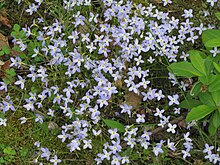
Gaillardia is a genus of flowering plants in the family Asteraceae, native to North and South America. It was named after Maître Gaillard de Charentonneau, an 18th-century French magistrate who was an enthusiastic botanist. The common name may refer to the resemblance of the inflorescence to the brightly patterned blankets made by Native Americans, or to the ability of wild taxa to blanket the ground with colonies. Many cultivars have been bred for ornamental use.

Helianthus is a genus comprising about 70 species of annual and perennial flowering plants in the daisy family Asteraceae commonly known as sunflowers. Except for three South American species, the species of Helianthus are native to North America and Central America. The best-known species is the common sunflower. This and other species, notably Jerusalem artichoke, are cultivated in temperate regions and some tropical regions, as food crops for humans, cattle, and poultry, and as ornamental plants. The species H. annuus typically grows during the summer and into early fall, with the peak growth season being mid-summer.
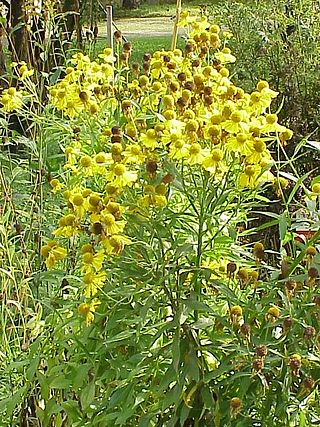
Helenium is a genus of annuals and herbaceous perennial plants in the family Asteraceae, native to the Americas.

Bouteloua is a genus of plants in the grass family. Members of the genus are commonly known as grama grass.
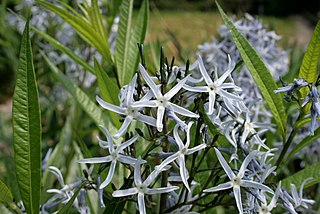
Amsonia is a genus of flowering plants in the dogbane family, Apocynaceae, first described as a genus in 1788. It is native primarily to North America with one species in East Asia and another in the eastern Mediterranean. It was named in honor of the American physician John Amson. Members of the genus are commonly known as bluestars.
- Amsonia ciliataWalter – fringed bluestar – SE US, S Great Plains
- Amsonia elliptica(Thunb. ex Murray) Roem. & Schult. – Japanese bluestar – China, Japan, Korea
- Amsonia fugateiS.P.McLaughlin – San Antonio bluestar – New Mexico
- Amsonia grandifloraAlexander – Arizona bluestar – Arizona, Sonora, Durango
- Amsonia hubrichtiiWoodson – Hubricht's bluestar – Arkansas, Oklahoma
- Amsonia illustrisWoodson – Ozark bluestar – Mississippi Valley, also Nevada
- Amsonia jonesiiWoodson – Jones' bluestar – Arizona, New Mexico, Utah, Colorado
- Amsonia kearneyanaWoodson – Kearney's bluestar – Baboquivari in Pima Co. in Arizona
- Amsonia longifloraTorr. – tubular bluestar – Arizona, New Mexico, Texas, Coahuila
- Amsonia ludovicianaVail – Louisiana bluestar – Louisiana, Mississippi, Georgia
- Amsonia orientalisDecne. – European bluestar – Greece, Turkey
- Amsonia palmeriA.Gray – Palmer's bluestar – Arizona, New Mexico, Texas, Sonora, Chihuahua
- Amsonia peeblesiiWoodson – Peebles' bluestar – Arizona
- Amsonia repensShinners – creeping bluestar – E Texas, SW Louisiana
- Amsonia rigidaShuttlw. ex Small – stiff bluestar – from Georgia to Louisiana
- Amsonia tabernaemontanaWalter – eastern bluestar – S + C + E United States
- Amsonia tharpiiWoodson – feltleaf bluestar – W Texas, SE New Mexico
- Amsonia tomentosaTorr. & Frém. – woolly bluestar – SW US; Chihuahua

Houstonia caerulea, commonly known as azure bluet, Quaker ladies, or bluets, is a perennial species in the family Rubiaceae. It is native to eastern Canada and the eastern United States. It is found in a variety of habitats such as cliffs, alpine zones, forests, meadows and shores of rivers or lakes.

Oldenlandiopsis (creeping-bluet) is a genus of flowering plants in the family Rubiaceae. It is monospecific, comprising only one species, Oldenlandiopsis callitrichoides. This species had previously been placed in Hedyotis or in Oldenlandia. It is native to the West Indies, southern Mexico, and Central America. It is naturalized elsewhere, including Florida, Hawaii, South America, and tropical Africa.
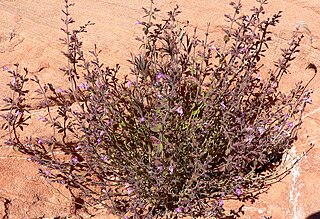
Hedeoma is a genus of flowering plants in the mint family, Lamiaceae. It is native to North and South America. They are commonly known as false pennyroyals.
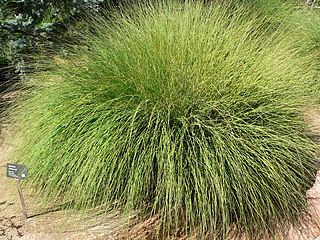
Muhlenbergia is a genus of plants in the grass family.
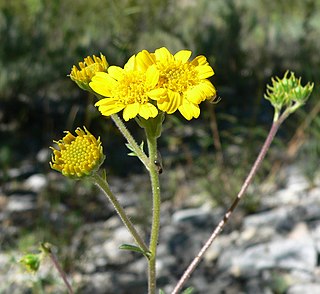
Hymenothrix is a small genus of North American flowering plants in the daisy family known as thimbleheads. They are native to the southwestern United States and northern Mexico.

Ratibida is a genus of North American plants in the tribe Heliantheae within the family Asteraceae. Members of the genus are commonly known as prairie coneflowers or mexican-hat.

Amoreuxia is a genus of flowering plants in the achiote family, Bixaceae. It was formerly placed in the family Cochlospermaceae. Members of the genus are commonly known as yellowshow. They are native to Mexico, Central America, Colombia, Peru, Curaçao, and the southwestern United States.
- Amoreuxia gonzaleziiSprague & L.Riley – Santa Rita Mountain yellowshow - Sonora, Sinaloa, Jalisco, southern Arizona
- Amoreuxia malvifoliaA.Gray - Chihuahua, Durango
- Amoreuxia palmatifidaMoc. & Sessé ex DC. – Mexican yellowshow - Mexico, Central America, Colombia, Arizona, New Mexico
- Amoreuxia wrightiiA.Gray – Wright's yellowshow - Curaçao, Peru, Chihuahua, Durango, Coahuila, Nuevo León, San Luis Potosí, Tamaulipas, Campeche, Yucatán, Quintana Roo, Campeche, Texas
Houstonia acerosa, the New Mexico bluet or needleleaf bluet, is a plant species native to Chihuahua, Coahuila, Nuevo León, Tamaulipas, San Luis Potosí, Texas and New Mexico.
Houstonia palmeri, the Saltillo bluet, is a plant species in the family Rubiaceae, native to the Mexican states of Coahuila and Nuevo León.

Houstonia humifusa, commonly called matted bluet, is a plant species in the coffee family (Rubiaceae). It is native to the United States, where it is found in Texas, Oklahoma, and New Mexico. It is typically found in sandy areas, or sometimes over gypsum.

Houstonia micrantha, the southern bluet, is a plant species in the coffee family.
Houstonia rosea, the rose bluet, is a North American plant species in the coffee family. It is a tiny plant only a few centimeters tall, with pink flowers. It is native to the south-central United States: Texas, Oklahoma, Arkansas, Louisiana, Mississippi, Alabama and southern Missouri.
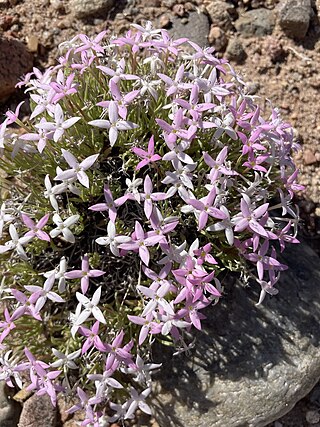
Houstonia rubra, the red bluet, is a plant species in the Rubiaceae. It is a small herb with white to pink to red to reddish-purple flowers, native to the southwestern United States and northern and central Mexico: Coahuila, Nuevo León, Hidalgo, Zacatecas, Guanajuato, Puebla, Sonora, Durango, Chihuahua, Arizona, New Mexico, southeastern Utah and western Texas.

Houstonia serpyllifolia, commonly called thymeleaf bluet, creeping bluet, mountain bluet, Appalachian bluet or Michaux's bluets is a species of plant in the coffee family (Rubiaceae). It is native to the eastern United States, where it is found in the central and southern Appalachian Mountains. It has been documented in the states of Pennsylvania, Maryland, West Virginia, western Virginia, North Carolina, South Carolina, Kentucky, Tennessee, Ohio, and northeastern Georgia.

Houstonia wrightii, the pygmy bluet, is a plant species in the Rubiaceae. It is native to the south-western United States and northern Mexico.
